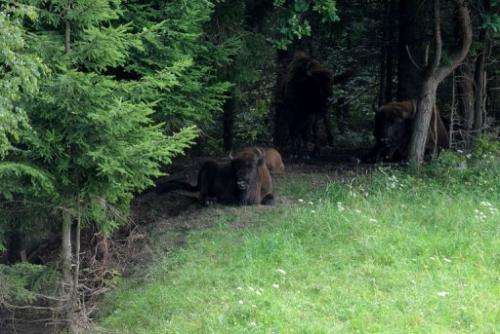Ex-Soviet military zone hosts Czech bison revival

European bison have returned to the Czech Republic after more than a century, as five animals from neighbouring Poland make their home in a former military zone occupied by the Soviets from 1968 to 1991.
"European bison always lived in the Czech lands until their extermination in the 19th century, so they must come back," said Jiri Janota, mastermind of the drive to bring back Europe's biggest indigenous land mammal.
"Besides, they're one of the most beautiful species on earth," he added.
Kahunka, Kartinka, Karvina and Kasztelanka, four females, have come from the eastern Polish park of Bialowieza, which boasts the biggest population of the species in Europe.
Porto, the only male in the new Czech herd, has arrived from Kampinos, a national park near the Polish capital Warsaw.
European bison -- or Wisent, a German cousin of the American bison -- were once abundant on the territory of what is now the Czech Republic, but gradually fell victim to hunters and deforestation.
Up to now, the animal dubbed "Zubr" in Czech had only survived in the names of villages such as Zubri et Zubrnice, as well as in the names of popular drinks, the Zubr beer and Zubrovka vodka.
Five giants with thick brown hides look absolutely happy as they savour their forage in an undulating enclosure spanning six hectares (15 acres), with a pine, spruce and birch forest, a tiny brook and a prairie.
Behind a fence three metres (yards) high, the small herd is waiting to be released to controlled freedom in the vast reserve of Zidlov, covering an area of some 3,800 hectares (9,400 acres) about 60 kilometres (37 miles) northeast of Prague.
"The project reckons with a group of 25-30 animals in the end," said Janota, head of the state-controlled company Vojenske lesy a statky (Military Forests and Assets).
"One of the tasks we are facing is to come up with 20 female names starting with "Ka" and male names starting with "Po"," he said with a smile, referring to the genealogy rules for the species.
Managed by Vojenske lesy a statky, the Zidlov reserve is part of the former Ralsko military zone spanning about 250 square kilometres (98 square miles), of which 220 are uninhabited.
The vast training zone, created after World War II at the expense of the merciless destruction of 16 villages, was confiscated, pure and simple, by the Red Army after its occupation of former Czechoslovakia in 1968.
The Soviets only left the zone two years after the 1989 Velvet Revolution that toppled communist rule in Czechoslovakia, which split peacefully into two countries in 1993.
After the failure of scores of revitalisation projects -- including the megalomaniac idea of transforming the local former military airport into one of the continent's major air traffic hubs -- the area of picturesque hills, ponds, spruce forests and sandstone rocks has become an eldorado for bikers.
"The natural environment here is ideal for the European bison," said Jan Kocourek, a young forester driving a Land Rover.
The future co-existence of European bison with deer, mouflon, roe- and fallow-deer -- who have lived in the Zidlov reserve for ages -- will "definitely be without problems," he added.
The only concern is a potential encounter between the giant animal -- boasting two metres (almost seven feet) of height and 3.5 metres (over 11 feet) of length, two pointed horns and unpredictable manners especially during the rutting season -- with its most dangerous predator, the human.
"I have consulted experts in Poland and other countries over this issue," said Janota.
"The European bison will never attack anyone who behaves with humility and respect for nature, and who keeps a safe distance," he added.
(c) 2011 AFP



















